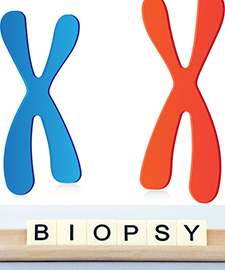Image-Guided Biopsy: The Next-Generation Biospecimen
 In his 2015 State of the Union address, President Obama committed to “launching a new Precision Medicine Initiative to bring us closer to curing diseases like cancer and diabetes; and to give us all access to the personalized information we need to keep ourselves and our families healthier.” This paradigm of health care where an individual’s genetic information is used as the basis for treatment is here to stay and is a primary driver of drug development strategies and clinical trial design.
In his 2015 State of the Union address, President Obama committed to “launching a new Precision Medicine Initiative to bring us closer to curing diseases like cancer and diabetes; and to give us all access to the personalized information we need to keep ourselves and our families healthier.” This paradigm of health care where an individual’s genetic information is used as the basis for treatment is here to stay and is a primary driver of drug development strategies and clinical trial design.
Real-time tissue acquired via an image-guided biopsy in NCI-MATCH
In oncology, the most common way by which a tumor’s molecular profile is assessed is through tissue acquired via an image-guided biopsy.
The National Cancer Institute (NCI) is currently conducting one of the largest multi-arm, phase 2 trials, NCI-Molecular Analysis for Therapy Choice (NCI-MATCH or EAY131), where the analysis of tissue obtained from real-time biopsies will determine a patient’s treatment; drugs that target the tumor’s specific genetic abnormalities will treat the patients. The trial is unique in undertaking this type of personalized therapy for multiple cancer types at one time, and for its deliberate strategy to encourage the participation of both academic and community hospitals to open access for patients to this trial.
Image-guided biopsy in our practices
For interventional radiologists who work exclusively in cancer centers or have large interventional oncology practices, it is clear that a biopsy providing tissue that is sufficient only for a histological diagnosis is no longer satisfactory. It has become clear that the image-guided biopsy has been repurposed beyond merely serving to establish a diagnosis to being a procedure that is used at multiple time points during the disease course to render the necessary information to determine disease progression, next treatment steps, and prognosis. Implicit in this understanding is the acceptance of the need to be more aggressive during sampling, which often translates into obtaining multiple core biopsies using larger gauge needles and occasionally acquiring different types of specimens such as both fine-needle aspirates and core biopsies.
Image-guided biopsy challenges in MATCH
However, it is less clear whether the radiology community at large shares this viewpoint. After the accrual of 800 patients on MATCH, the trial was paused for an interim analysis in part to address problems with the quality of biopsy. Up to 1 in 5 biopsy samples were reported inadequate for genetic analysis. In some cases, fewer than the required four core biopsies were submitted, and these “shoddy biopsies” were denying “cancer patients a shot at personalized treatment.” The events of MATCH expose the current problems and opportunities that we as a medical community face with precision medicine: currently, 10% to 15% of patients do not have biopsy samples sufficient for mutational characterization by next-generation sequencing technologies. Oncologists and other stakeholders, who have long held the opinion that the high quality biospecimens are critical to the success of clinical trials and the development and validation of biomarkers, have underestimated the technical and biological challenges that can play into obtaining quality biopsies. It is also clear that education of the radiology community is needed on how the image-guided biopsy intended for genetic analysis differs from one intended only for histological diagnosis.
Approach to overcoming technical and biological challenges
In addition to the modifications in biopsy technique needed to allow for the acquisition of multiple biopsy specimens, the radiologist must also embrace a critical, clinical role for these patients. The radiologist is the most qualified to select the best lesion for biopsy and to determine the potential risk for biopsy-related procedural complications: there will be some patients who do not have lesions amenable for biopsy and some patients whose underlying medical comorbidities of anatomy make biopsy unsafe. Experience with the MATCH trial has precipitated a discussion of image-guided biopsies and included oncologists, pathologists, and interventional radiologists on the panel at the most recent Cancer Therapy Evaluation Program (CTEP) Early Drug Development meeting. Only by a multidisciplinary collaboration of oncologists, interventional radiologists, and pathologists can we move toward achieving the ideal of being able to successfully complete a genomic analysis for every cancer patient through an image-guided biopsy.
View here CIO Spotlight: Dr Tam on the role of biopsy in 2017.












